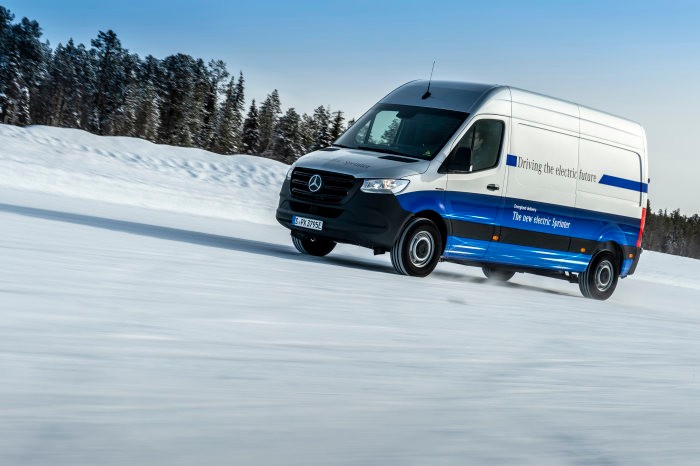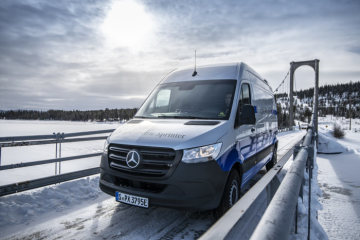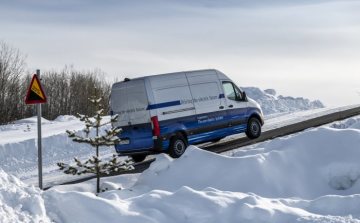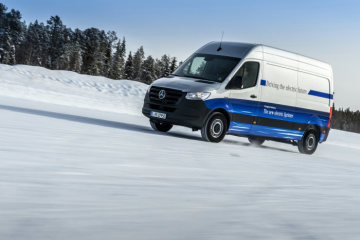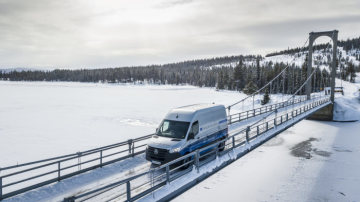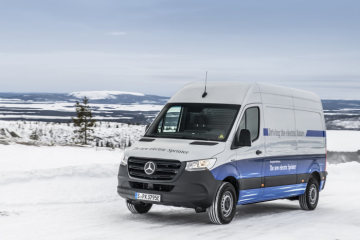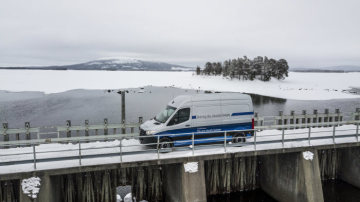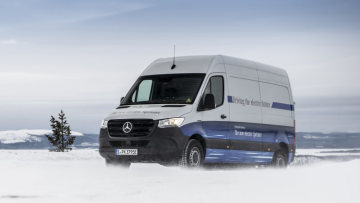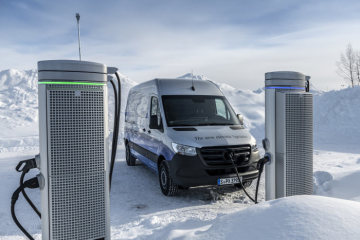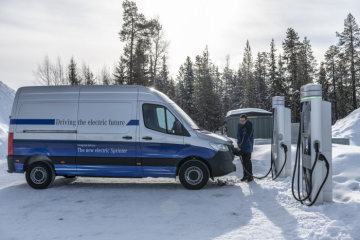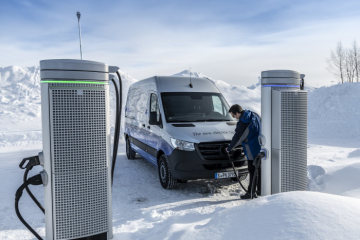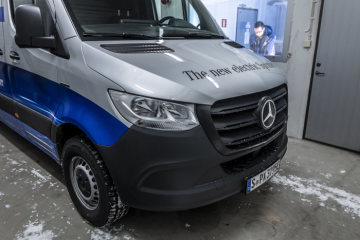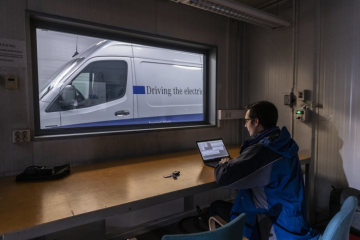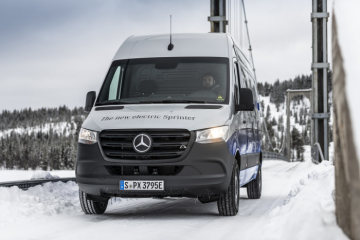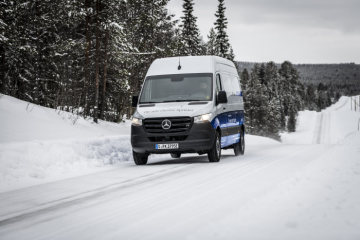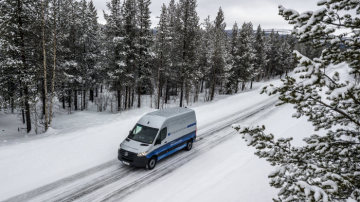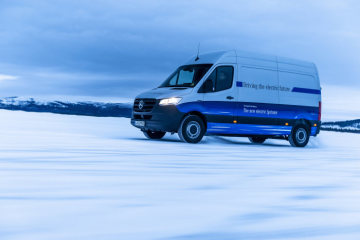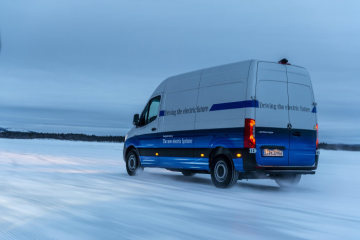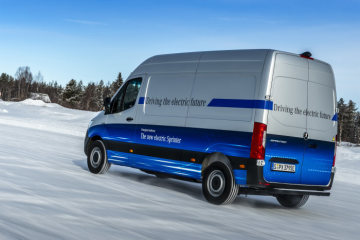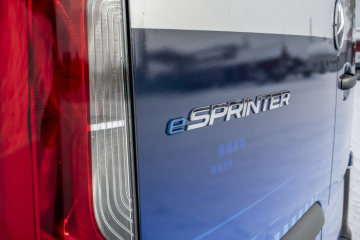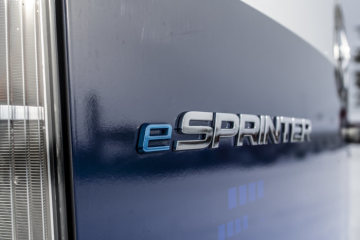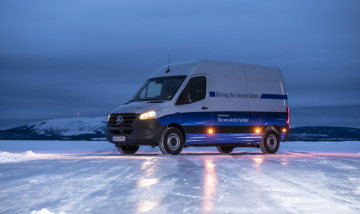
22.
March 2019
Arjeplog, Sweden
- Final winter tests show: the eSprinter is ready for its market launch
- Testing of charging and driving characteristics, range and low-temperature resistance in extreme conditions
- The focus at sub-zero temperatures: safety and ergonomics of the driver's workplace, reliable handling on ice and snow
- Comprehensive Electrification at Mercedes-Benz Vans: market launch of the eSprinter in the second half of 2019
Arjeplog, Sweden. Customers place the same demands on electric vans as they do on equivalent vehicles with combustion engines. One of the most important factors here: complete reliability – even in severe conditions. The winter endurance tests on the Mercedes-Benz eSprinter focussed precisely on this. For several weeks the development team subjected the fully-electric van to a true endurance test in Sweden's Arjeplog. At temperatures as low as minus 30 degrees with icy roads and deep snow, the eSprinter proved its operability under extreme conditions. Thus the vehicle completed one of its last milestones on the way to its market launch in the second half of 2019.
The vehicles were put through numerous complex tests on the difficult test site close to the Arctic Circle. Testing included driving on a frozen lake to examine the effects of extreme cold on handling, ergonomics and comfort using special measuring technology. The starting behaviour and low-temperature resistance of the drive components, software and interfaces were tested in cold cell facilities.
How the vehicles respond to different weather conditions is critical to the electric vans functioning in tough daily operations, for example in the CEP sector (courier, express, package). With a range of around 1501 kilometres when configured with a battery capacity of 55 kWh, the eSprinter is perfectly designed for inner-city short-radius distribution. The tests in Sweden have shown: even in the unfavourable conditions described here, a range of around 1001 km is still available to the customer.
Electromobility with Mercedes-Benz standards: high quality and safety demands are placed on the driver's workplace
Anyone who drives a van daily, places high demands on the driver's workplace. That is why quality and safety are equally important for electrically driven vans. Even at temperatures far below freezing, it must be possible to free the windows from ice as quickly as possible and heat the driver cabin reliably. To this end, the temperature of the test vehicles and their batteries was lowered to extremes in special cold cells in order to test the starting behaviour and thermal management during so-called cold starts. A further important element of the test: charging behaviour. The eSprinter is equipped with an integrated fast-charging function with which it can recharge around 80 % of its energy in 30 minutes – this is a great advantage in the daily routine of a van which must function reliably whatever the temperature.
Also, reliable handling in ice and snow as well as resistance of the components to wintry conditions are vital to daily operations. This is exactly what the team of more than 30 engineers, electronics experts and mechanics from Mercedes-Benz Vans have ensured in numerous tests in Sweden's Arjeplog. The conclusion of the testers was that the eSprinter is fit for customer operations – even in Arctic conditions.
“Yet again we asked a lot of our eSprinter during the final winter endurance tests,” says Benjamin Kaehler, Head of eDrive@VANs at Daimler AG. “Thanks to our comprehensive tests, we were able to squeeze out the last couple of percentage points from our second fully-electric van after the eVito on its way to complete market readiness. Particularly with regard to thermal management, so important to electric vans, we were able to gain insights which will make the eSprinter safer and more comfortable. We are very proud of the result and are looking forward to being able to offer our customers an extremely reliable product very soon that is more than suitable for everyday use, regardless of the conditions.”
eSprinter on a par with the founder of the segment
In Arjeplog, the eSprinter was subjected to its final winter endurance tests before it follows the eVito onto the market in the second half of 2019. Initially, the new eSprinter will be available as a panel van with a high roof and a permissible gross vehicle weight of 3500 kilogrammes. Its maximum load volume is 10.5 m³ just like a comparable Sprinter.
Equipped with a battery capacity of 55 kWh, its range is an estimated 1501 kilometres with a maximum payload of 900 kilogrammes. With the second battery option, customers can prioritise other operational parameters. A capacity of 41 kWh allows the payload to be increased by around 140 kilogrammes to a total of 1040 kilogrammes with a range of about 1151 kilometres. The integrated fast-charging function provides for more flexibility; 80 % of battery charge can be recharged within 30 minutes.
Similar to the entry-level diesel engine, the electric drive in the eSprinter has an output of 85 kW and a torque figure of up to 300 Newton metres. As for the eVito, the maximum speed can be configured to suit the task at hand: maximum speed can be set at 80 km/h, 100 km/h or even as much as 120 km/h.
Press Contact
- Van Technology Communications – eDrive@Vans
- oliver.fenzl@daimler.com
- Tel: +49 (0)711 17-4 54 64
- Fax: +49 (0)711 17-52030
Press Contact Overview
Media
Download
Filter
Show thumbnails
Show list
Slideshow

Do you really want to delete the data record?
Please wait a moment …
Please wait a moment …
Please wait a moment …
Please wait a moment …
-
19C0202_001
-
19C0202_002
-
19C0202_003
-
19C0202_004
-
19C0202_005
-
19C0202_006
-
19C0202_007
-
19C0202_008
-
19C0202_009
-
19C0202_010
-
19C0202_011
-
19C0202_012
-
19C0202_013
-
19C0202_014
-
19C0202_015
-
19C0202_016
-
19C0202_017
-
19C0202_018
-
19C0202_019
-
19C0202_021
-
19C0202_022
-
19C0202_023
-
19C0202_024
-
19C0202_025
-
19C0202_020

LoadingOriginal Article
